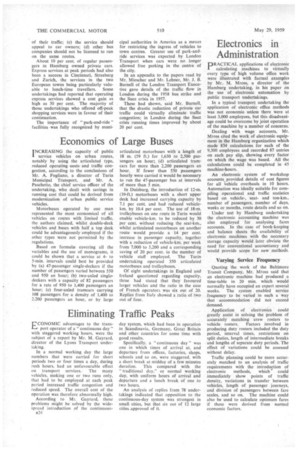• Raismg Service Efficiency
Page 57

Page 58

If you've noticed an error in this article please click here to report it so we can fix it.
'ADAPTATION DAPTATTON of passenger vehicles to other road traffic, the suppression of noise and the .need to cater for .changes in fashion, were essential to urban transport requirements in all countries, said Mr. 0. Miescher, a director of the Basle undertaking, in a review of investment in public transport as a means for competing with private transport.
Mr. Miescher asked the question: "Can the principle of economic self-sufficiency be maintained?" Opinions from Canada and America, he said, indicated that public transport was of such vital importance to the community that it should be supported to some extent by the taxpayer.
The mistake made by America in neglecting public transport in favour of private motoring in the early days was cited by Mr. F. Lehner, a director of Hanover undertaking, as an example which should be avoided in other parts Of the world.
In a paper on measures that could be taken to improve transport efficiency, he said the development of efficient public transport systems.was the only means for preventing the decay of cultural and business interests in the central areas of large towns. Public transport must be made attractive and competitive.
Dealing with the most suitable means for transport, Mr. Lehner said that according to an analysis of German undertakings the use of motorbuses and trolleybuses represented the most economic system for towns with populations of, up to 200,000.
Commenting on the American claim that the' replacement of tramways by motorbuses fostered traffic homogeneity, Mr. Lehner said that the improvement was limited. Motorbuses operating at short intervals in town centres should be provided with stopping places outside the main stream of traffic.
Referring to trolleybuses, Mr. Lehner stated that the proportion of traffic carried by these vehicles in Germany had increased by 2.3 per cent, since 1457. Total operating costs were comparable with motorbus costs for vehicles running at intervals of 15 to 45 min.
Quoting Mr. J. B. Burnell, operating manager of London Transport Executive, Mr. Lehner said that the bus progress record given by the Bus Electronic Scanning Indicator (B.E.S.I.) was justifying the highest hopes for the system and indicated the great value of scientific control of bus movements.
The machine had enabled 50-60 per cent. of traffic interruptions to be provided for without loss.
The possibility, of successfully operating an express bus service at higher fares had been realistically demonstrated by Hamburg Transport. The essential requirements were outlined as being: (a) that passengers should be assured a more comfortable and rapid journey; (b) normal services should be relieved of part
of their traffic; (c) the service should appeal to car owners; (d) other bus companies should not be licensed to run on the same routes.
About 10 per cent. of regular passengers in Hamburg owned private cars. Express services at peak periods had also been a success in Cincinnati, Strasburg and Zurich, the services in the two European towns being particularly valuable to lunch-time travellers. Some undertakings had reported that operating express services showed a cost gain as high as 30 per cent. The majority of those undertakings who offered off-peak shopping services were in favour of their continuation.
The importance of " park-and-ride " facilities • was fully recognized by muni cipal authorities in America as a means for restricting the ingress of vehicles to town centres. Greater use of park-andride services was expected by London Transport when cars were no longer allowed free parking in the centre of the city: In an appendix to the papers read by Mr. Miescher and Mr. Lehner, Mr. J. B. Burnell of the London Transport Executive gave details of the traffic flow in London during the 1958 bus strike and the Suez crisis in 1957.
These had shown, said Mr. Burnell, that the drastic reduction of private car traffic could virtually eliminate traffic congestion; in London during the Suez crisis running times improved by about 20 per cent.




































































































